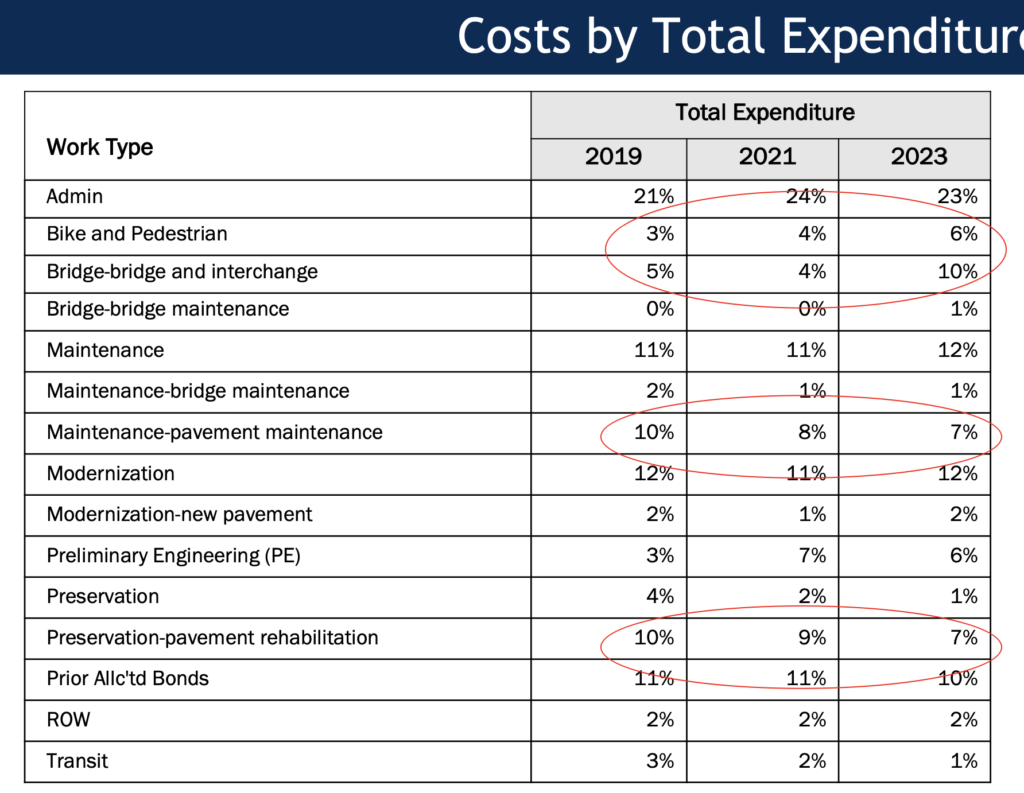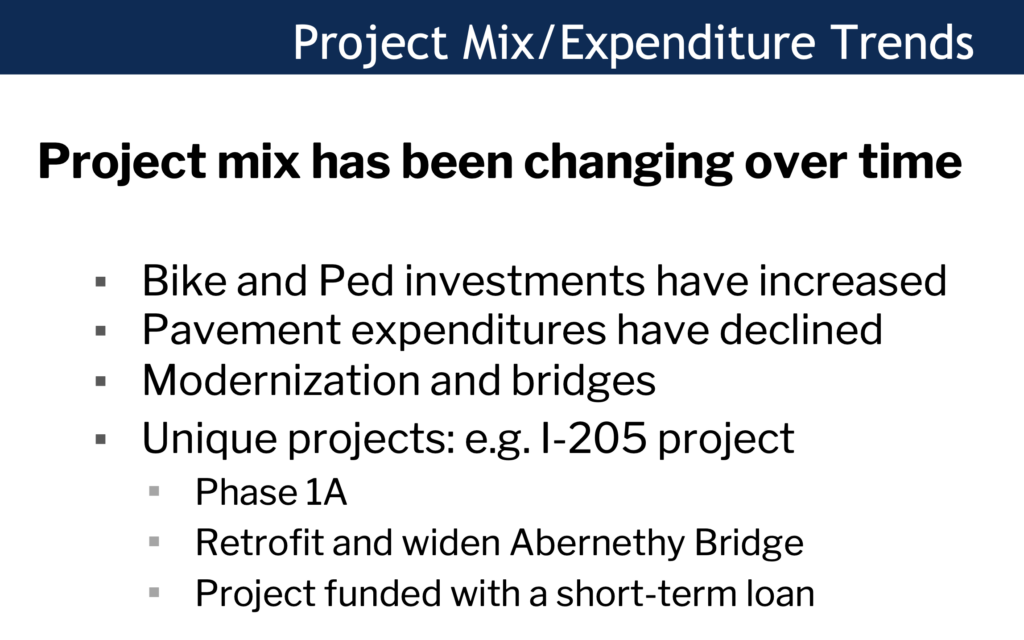There are good reasons to be dubious of claims that trucks are being over-charged for the use of Oregon roads.
The imbalance between cars and trucks seems to stem largely from the Oregon Department of Transportation”s decision to slash maintenance and preservation, and spend more widening highways.
ODOT could largely fix this “imbalance” by spending more fixing roads, and less on widening them.
ODOT has illegally included federal funds in its cost allocation study; the state’s law and constitution apply only to state funds.
ODOT has gone out of its way to scapegoat bike and pedestrian projects, which are mostly paid for with federal funds—that aren’t even properly included in the allocation study.
And the highway cost allocation study leaves out huge social, environmental and fiscal costs that cars and trucks impose on society and on the state.
In January, the Oregon Trucking Association filed suit against the State of Oregon, alleging that trucks were being illegally over-charged for their use of Oregon roads. The lawsuit is based on a provision of Oregon law that requires a “fair” division of road costs between trucks and cars, and an arcane report called the “Highway Cost Allocation Study (HCAS).”
The truckers point to the latest version of this biennial study, which in June concluded that trucks were responsible for 26 percent of highway costs, but contributed 36 percent of state highway revenue. The difference, about $200 million per year, they argue represents the amounts that they are being overcharged.
There are, however, several huge problems with this study, which neither the truckers nor the Oregon Department of Transportation are willing to acknowledge.
The imbalance is due to spending less to fix roads and more widening them
The first is the “imbalance” problem is largely due to ODOT’s decision to spend less on preservation and maintenance (re-paving, filling potholes), which are costs attributable primarily to trucks, and to spend more on expanding Portland area highways (which are costs attributable to cars). As we’ve pointed out at City Observatory, ODOT has systematically shortchanged preservation and maintenance to cobble together money for highway expansion projects. And recently, in threatened to slash snow plowing, even as it racked up massive cost-overruns for highway expansion projects. All this is fueling the “imbalance.”
According to HCAS, almost half of the imbalance is due to a “change in project mix.” The HCAS study finds that different kinds of expenditure are differently attributable to cars and to trucks. Expanding peak hour capacity is attributed mostly to peak hour VMT (overwhelmingly cars).
ODOT has cut spending on pavement maintenance and preservation from 24% of expenditures to 15% of expenditures. At the same time, it has doubled the share of its spending on Preliminary Engineering (i.e. planning for a series of freeway widening proejct) from 3% to 6%. (ODOT presentation, Slide 17).
What this means is ODOT could reduce or resolve the cost- responsibility problem by spending more on the highway costs that are attributable to trucks trucks, i.e. repaving roads.
Illegally counting federal funds
A second problem is that the HCAS illegally mingles federal funds with state funds in its calculations.. The HCAS law applies ONLY to state revenues, but ODOT has chosen to count federal funds as well. There is no legal reason why federal funds spent on bike/ped projects, for example, should affect the HCAS allocation, but ODOT pretends they do. And, as you know, for every single project, ODOT knows to the penny how much federal money it spent on that project.
ODOT illegally includes federal funds in the HCAS. Federal funds spent on bikes, transit and pedestrians gets counted as influencing the cost allocation of state funds, which is not consistent with the Oregon Constitution or Oregon Law. ODOT should exclude all federal funds from the HCAS.
Nothing in the law or constitution directs or authorizes including federal funds in the HCAS calculations. The HCAS requirement applies exclusively to state authorized road user fees. The Oregon Constitution is clear that this applies only to state taxes and fees:
(3) Revenues described in subsection (1) of this section that are generated by taxes or excises imposed by the state shall be generated in a manner that ensures that the share of revenues paid for the use of light vehicles, including cars, and the share of revenues paid for the use of heavy vehicles, including trucks, is fair and proportionate to the costs incurred for the highway system because of each class of vehicle. The Legislative Assembly shall provide for a biennial review and, if necessary, adjustment, of revenue sources to ensure fairness and proportionality.
Oregon Constitution, Article IX(3a) (Emphasis added)
ODOT is strictly accountable to show that it spends federal funds and state funds only on eligible uses. It legally tracks the use of federal funds for every project separately. There’s no technical reason these can’t be excluded. ODOT includes these funds based on the false claim that federal and state funds are “interchangeable,” something they maintain is impossible in every other context.
State Expenditures. All state expenditures of highway user fee revenues are allocated to vehicle weight classes, as are all state expenditures of federal highway funds (e.g., matching funds). Federal funds are included because they are interchangeable with state user fee revenues. Any differences in the way they are spent are arbitrary and subject to change.
ECONW, 2021-23 Highway Cost Allocation Study, Page 16 (emphasis added)
Any court that takes a close look at the Highway Cost Allocation Study will have to conclude that ODOT has committed a serious error by co-mingling federal funds (which aren’t subject to the HCAS requirement) with state funds (which are). If the study were revised to include only at state funds, which is all the law applies to, there may not be an imbalance at all.
ODOT singles out an increase in spending on bike/ped projects as a reason why the mix of projects it funds are shifting the revenue allocation away from trucks.
A ODOT second slide emphasizes spending on bike/ped projects; there is no comparable slide showing the $622 million allocated for the I-205 Abernethy Bridge project, which is overwhelmingly state funding, and which dwarfs the amount spent all on bike and pedestrian projects.. ODOT has made a conscious decision to scapegoat bikes, while it says nothing about the billions of dollars it is spending on highway expansion projects, which are experiencing vast cost overruns.
ODOT is including several almost entirely federally funded bike/ped projects to influence the HCAS. There’s no legal or logical reason why amounts of federal funds spent on bikes, pedestrian facilities or transit should affect the allocation of state funding between cars and trucks.
Plenty of other problems with highway cost allocation
The illegal inclusion of federal funds in the cost allocation study is just the tip of the iceberg of questionable assumptions behind the study. Here are three other issues that should be considered.
First, the study doesn’t fully address the social and environmental costs of roads. The HCAS study looks only an road expenditures, and doesn’t look at all the other costs that cars and trucks impose on society, and on state and local government. The cost of pollution, crashes, policing, stormwater runoff, climate change and other costs are not reflected in the study. The US Congressional Budget Office estimates that heavy trucks cause $57 billion to $128 billion in social and environmental cost per year, several times what they pay in all state and federal user fees. If we include all the direct and indirect costs associated with roads, both cars and trucks are massively subsidized, and pay far less than their “fair share” toward the cost of roads.
Second, there are many essentially arbitrary assumptions in the HCAS. Chief among them: the allocation of administration costs. More than a fifth of all spending is treated as “administration.” The study chooses to allocate these solely based on vehicle miles traveled, which disproportionately attributes these costs to cars rather than trucks. Instead, the administrative costs could be just as reasonably allocated proportional to all other costs in the study (this would be essentially neutral between cars and trucks–it would say that administration doesn’t influence the cost allocation.
Third, the HCAS isn’t really a cost allocation study, its an expenditure allocation study. The highway system incurs costs, particularly for deferred maintenance, whether it pays them in any given year or not. Arguably, the imbalance in the current study reflects ODOT’s failure to deal with its substantial maintenance backlog. It has cut spending on fixing roads, and spent more on expanding them—but these costs have not been avoided, they’ve merely been postponed, and likely increased, as a result. A true “cost allocation” study would make an allowance for the annual depreciation and maintenance costs that the system incurs, whether or not ODOT spends money on these items in any particular year. Ironically, this is exactly the approach that ODOT is employing to set its budget for tolled roadways: setting aside funds from tolls to cover future capital replacement, repair, and operating costs. ODOT has shown it can easily apply this basic accounting accounting concept to highways.
Bike Portland Interviews Joe Cortright on the Highway Cost Allocation Study
Jonathan Maus of Bike Portland interviewed Joe Cortright about the highway cost allocation study here



